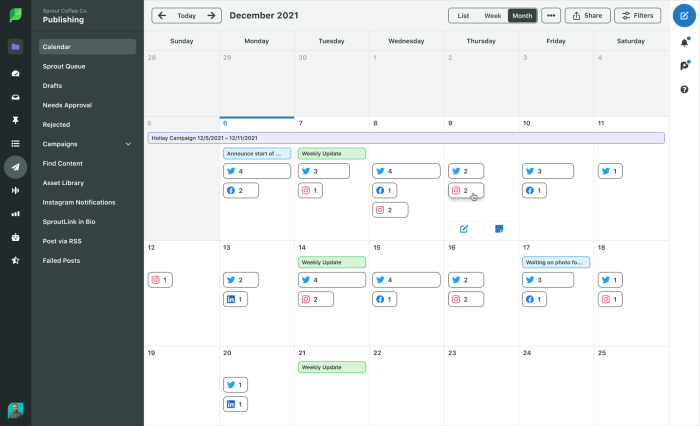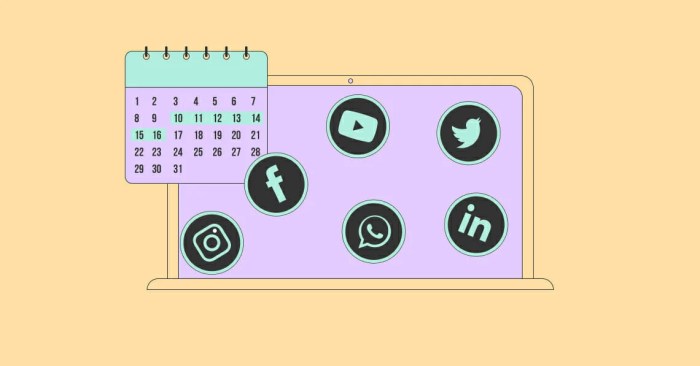Social Media Scheduling Tools take the spotlight in this digital age, offering businesses a strategic advantage in managing their online presence with ease and efficiency. Get ready to dive into the world of scheduled posts and automated content delivery!
In today’s fast-paced digital landscape, staying ahead of the curve with social media management is crucial for any business looking to make an impact online.
Overview of Social Media Scheduling Tools
In today’s fast-paced digital world, social media scheduling tools have become essential for businesses looking to effectively manage their online presence. These tools allow users to plan, create, and schedule posts across various social media platforms, helping businesses maintain a consistent and engaging presence for their audience.
Popular Social Media Scheduling Tools
- Hootsuite: One of the most well-known social media scheduling tools, Hootsuite allows users to schedule posts, track analytics, and manage multiple accounts all in one platform.
- Buffer: Buffer is another popular tool that enables users to schedule posts, analyze performance, and collaborate with team members to streamline their social media efforts.
- Later: Particularly popular among Instagram users, Later offers visual planning tools, analytics, and the ability to schedule posts for optimal engagement.
Importance of Using Social Media Scheduling Tools
Social media scheduling tools play a crucial role in effective social media management by allowing businesses to:
- Save time: By planning and scheduling posts in advance, businesses can maintain a consistent online presence without the need for constant manual posting.
- Improve consistency: With scheduling tools, businesses can ensure that their posts are published at the best times for maximum reach and engagement, leading to a more cohesive brand image.
- Analyze performance: These tools provide valuable insights into the performance of social media campaigns, allowing businesses to refine their strategies and optimize their content for better results.
Features to Look for in Social Media Scheduling Tools

When choosing a social media scheduling tool, it’s important to consider key features that can help streamline your social media management process and maximize your online presence. Different tools offer unique functionalities that cater to specific needs, so it’s essential to evaluate them based on your requirements.
Content Calendar Management
Having a robust content calendar management feature is crucial for organizing and planning your social media posts effectively. Look for tools that offer customizable calendars where you can schedule posts, view upcoming content, and easily make changes as needed.
- Ability to schedule posts in advance
- Option to categorize content by type or platform
- Drag-and-drop functionality for easy rearranging of posts
Analytics and Reporting Capabilities
Analytics and reporting play a significant role in understanding the performance of your social media efforts. Choose a tool that provides detailed insights into key metrics such as engagement, reach, and click-through rates to help you optimize your content strategy.
- Real-time analytics for monitoring post performance
- Ability to generate customized reports for in-depth analysis
- Integration with popular analytics tools like Google Analytics
Team Collaboration Features
If you work with a team on your social media accounts, look for tools that offer collaboration features to streamline communication and workflow. Features such as team member permissions, task assignments, and approval workflows can help enhance productivity and coordination.
- Assign roles and responsibilities to team members
- Track changes and revisions made by team members
- Facilitate communication within the tool for seamless collaboration
Benefits of Using Social Media Scheduling Tools
In today’s fast-paced digital world, social media scheduling tools offer a plethora of benefits for individuals and businesses alike. From saving time to improving engagement, these tools have become essential for an effective social media strategy.
Automating Social Media Posts
- By automating social media posts through scheduling tools, you can save valuable time and ensure your content is consistently shared with your audience.
- These tools allow you to plan and schedule posts in advance, making it easier to maintain an active online presence without constantly being glued to your devices.
Consistent Posting Schedule
- One of the key advantages of using social media scheduling tools is the ability to maintain a consistent posting schedule.
- Consistency is crucial for building brand awareness and keeping your audience engaged, and scheduling tools help you achieve this by ensuring a steady stream of content.
Improving Overall Social Media Strategy
- By utilizing scheduling tools, you can strategically plan your content calendar, ensuring a mix of promotional, educational, and engaging posts to cater to your audience’s interests.
- These tools also provide valuable analytics and insights into the performance of your posts, helping you refine your social media strategy for better results.
Best Practices for Utilizing Social Media Scheduling Tools

Using social media scheduling tools can be a game-changer in managing your online presence. To make the most out of these tools, here are some best practices to keep in mind:
Content Variety and Timing
- Ensure a diverse range of content types such as images, videos, polls, and links to keep your audience engaged.
- Plan your content calendar strategically to align with peak engagement times for your target audience.
- Experiment with different posting frequencies and timings to determine what works best for your followers.
Engaging with the Audience
- Respond to comments, messages, and mentions promptly to foster a sense of community and connection with your audience.
- Use interactive elements like polls, quizzes, and calls to action to encourage participation and feedback from your followers.
- Personalize your scheduled posts by addressing your audience directly and creating a conversational tone.
